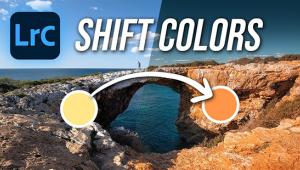It Can be Tough to Be a Photographer These Days
![]()
Commentary
It Can be Tough to Be a Photographer These Days
by George Schaub
We all know the hazards of the photojournalists' trade, those brave men and women who put themselves in harm's way to be a witness to our times. They become the eyes and conscience of the world, and many have paid the ultimate price for the dedication to their work. While more than worthy of praise and discussion, the topic here is not about photojournalists but about everyday photographers and teachers and how the state of mind within our society is making it tougher to be a photographer these days.
Though quashed to a certain extent, proposed permit rules for photographers in New York City are a case in point. The proposed rules required city-issued permits and proof of insurance for any person using a handheld camera in any public area if in a group of two or more for more than thirty minutes. (Let the roundup of tourists begin.) Furthermore, the new rules would require small groups using a single tripod for more than ten minutes to obtain a permit. (Gentlemen, raise your ISO!)
This is not something new, mind you, just an amping up of some already odd restrictions. I remember teaching a workshop back in the late 1990's and bringing a group of students from the New School to Lincoln Center, the bastion of the performing arts in New York. Some of the students brought along tripods, as we were planning to do some PC lens work in this architecturally interesting area. As soon as we crossed onto the Lincoln Center property we were swooped in on from three sides, with guards telling us in no uncertain terms to leave. When I asked why they told us that you need a permit to shoot if you are a professional photographer on their private property. But, I protested, I am teaching a class, and even showed them an ID card from the university.
As it turned out what tipped them off were the tripods. I asked one of them what would happen if we came on the grounds without the tripods, and they told us that would be OK. So we parked the tripods just over the property line and rotated students standing guard (this was New York) and they actually let us come in and shoot! We used curbs, fountain edges and railings to steady the cameras, and they just stood by with no intrusion. I am taking a group of students to photograph at the NYC Marathon in Central Park this week and we all will have tripods; we'll see what happens.
The Lincoln Center silliness is mild compared to the level of photographic paranoia in New York today. Everywhere you go there are signs disallowing photography, from tunnel entrances to building atriums and especially at transportation hubs. While this might be understandable it also borders on the absurd, considering how I can go up on Google Earth and get as detailed a shot of any site I want within seconds, especially in New York City. I recently was walking around the Wall Street area and was having fun shooting building angles and shadows. I was approached four times by men who had no shield or uniform, all challenging me about my activities. In three of the cases I got the feeling that I was on the verge of having my camera seized. When queried by them as to my activities I said, "I'm just taking pictures of the shadows and light", or "I'm just a tourist", or "Just taking pictures." They looked at me like I was nuts, like how could I even be so stupid to think this activity is allowed.
But that old paranoia runs deep, and we are all affected by it. Not far from where I live are a set of oil storage tanks painted in very colorful ways that I used to use as a scene for film tests. I wouldn't even think of walking by there with a camera today, knowing that I could be hauled in for such suspicious activity as testing the saturation level of Velvia 50 vs Ektachrome 100. In the city I enjoy taking street pictures, but now I am beginning to feel that I should limit my gear to a little point and shoot camera and wear Bermuda shorts to avoid getting hassled. Indeed, a freelancer in New York was recently arrested for using flash near a police scene (and not stopping when told to stop by the cops), with the cops using the excuse that a camera flash could set off an explosive device. Yikes. Maybe that's true and maybe the cops were just being overly cautious, but once again gives you a sense of the state of mind going around these days.
I'd like to close this with some quotes from an article written by one Alfred Toombs entitled "Unwitting Spies Beware" with a sell line stating: "Fine and imprisonment await all persons who, unknowingly or intentionally, take pictures which reveal defense secrets." It was published in the March 1940 Popular Photography. Just follow along replacing "spy" with "terrorist."
Toombs builds the gate in the lead paragraph by telling us: "There is nothing...a spy would rather be taken for than just a plain, American photographer." He then begins to go on about certain restrictions, many of which make sense in terms of military installations, gun emplacements, etc. But then the chilling remarks begin with: "The regulations apply with equal force to those who unwittingly take pictures which reveal defense secrets and to those who deliberately use cameras to spy." The obvious problem with the common sense rules about not taking pictures of military or defense installations, Toombs tells us, is that "previously the government (had) to prove that the photographer was engaged in activity for a foreign power" to make an arrest. The amended law, particularly Section 45, removed this onerous restriction from the government. "All that is required now is that the cameraman handled a picture of something that is forbidden."
"The details of what areas and what installations are to be considered vital are contained in the draft of the Executive Order", writes Toombs. "These details are of local interest and photographers would do well to become acquainted with them as they apply to their own communities."
One section of Section 45 is of particular historical interest. Writes Toombs,
"The third section makes the act, in effect, retroactive by halting the
circulation of such pictures of vital areas as have already been made. This
means that...a photographer would be violating the law if he sells or gives
away a prohibited picture. Similarly, publication in periodicals of such pictures
is banned." He later tells us that, "Certainly if you have in your
possession some old prints showing matters of military interest you would be
wise to have a responsible military officer approve them before you circulate
them."
And the story ends on this attempt at humor; "Always get permission before
you operate. If in doubt, submit your pictures for inspection. A year in a Federal
darkroom is a long time."
That was then and this is now. Not photographing military and vital infrastructure makes sense; never did. Not knowing what constitutes same is what makes many photographers confused and even hostile to restrictions. Is New York a military installation? Is some building atrium a vital emplacement? Is my going with a group of 15 students with tripods to stand in one place for more than half an hour to photograph the NY Marathon a threat to our national interest?
Restrictions on photography are growing all the time. It's important to discuss this amongst ourselves and to bring regulations out in the open. Shedding light on things is part of our craft. We might discover that some might make sense; others, once accepted, might lead us straight back to Section 45.
- Log in or register to post comments












































